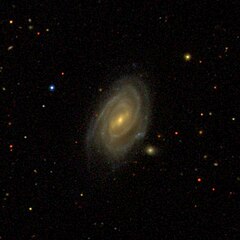NGC 2927
| NGC 2927 | |
|---|---|
 The barred spiral galaxy NGC 2927 | |
| Observation data (J2000 epoch) | |
| Constellation | Leo |
| Right ascension | 09h 37m 15.21s[1] |
| Declination | +23° 35′ 26.209″[1] |
| Redshift | 0.025147[1] |
| Heliocentric radial velocity | 7539 ± 2 km/s[1] |
| Distance | 376.7 ± 26.4 Mly (115.49 ± 8.09 Mpc)[1] |
| Apparent magnitude (V) | 12.9[1] |
| Characteristics | |
| Type | SAB(rs)b[1] |
| Size | ~229,000 ly (70.20 kpc) (estimated)[1] |
| Apparent size (V) | 1.3′ × 1.0′[1] |
| Other designations | |
| IRAS F09343+2349, 2MASX J09371521+2335261, UGC 5122, MCG +04-23-016, PGC 27385, CGCG 122-032[1] | |
NGC 2927 is a large barred spiral galaxy in the constellation of Leo. Its velocity with respect to the cosmic microwave background is 7830 ± 20 km/s, which corresponds to a Hubble distance of 115.49 ± 8.09 Mpc (~377 million light-years).[1] In addition, three non-redshift measurements give a distance of 120.667 ± 0.882 (~394 million light-years).[2] The galaxy was discovered by German astronomer Heinrich d'Arrest on 21 February 1863.[3]
The SIMBAD database lists NGC 2927 as a radio galaxy, i.e. it has giant regions of radio emission extending well beyond its visible structure.[4]
One supernova has been observed in NGC 2927: SN 2023uvg (type Ic, mag. 18.7389) was discovered by the Automatic Learning for the Rapid Classification of Events (ALeRCE) on 13 October 2023.[5]
NGC 2927 forms a pair of galaxies with NGC 2929.[6]
See also
[edit]References
[edit]- ^ a b c d e f g h i j k "Results for object NGC 2927". NASA/IPAC Extragalactic Database. NASA and Caltech. Retrieved 14 August 2024.
- ^ "Distance Results for NGC 2927". NASA/IPAC EXTRAGALACTIC DATABASE. NASA. Retrieved 14 August 2024.
- ^ Seligman, Courtney. "NGC 2927". Celestial Atlas. Retrieved 14 August 2024.
- ^ "NGC 2927". SIMBAD. Centre de données astronomiques de Strasbourg. Retrieved 16 December 2024.
- ^ "SN 2023uvg". Transient Name Server. IAU. Retrieved 14 August 2024.
- ^ Mahtessian, A. P. (1998). "Groups of galaxies. III. Some empirical characteristics". Astrophysics. 41 (3): 308–321. Bibcode:1998Ap.....41..308M. doi:10.1007/BF03036100.
External links
[edit] Media related to NGC 2927 at Wikimedia Commons
Media related to NGC 2927 at Wikimedia Commons- NGC 2927 on WikiSky: DSS2, SDSS, GALEX, IRAS, Hydrogen α, X-Ray, Astrophoto, Sky Map, Articles and images
